The White Lady is a classic cocktail invented in the late 1910s. A very citrus-forward and refreshing Gin drink created by Harry MacElhone. MacElhone was a famous bartender, mostly known for his book "The ABC of Mixing Cocktails". But as classic as the cocktail recipe is, ultimately, it was not what MacElhone initially imagined.
Read on to learn more about this classic Gin cocktail and how you can make this smooth drink at home.
The three essential components to making a White Lady cocktail are Gin, Triple Sec, and lemon juice. However, depending on where you look, you will find recipes that incorporate additional ingredients.
But before I get to those, I want to say that the standardized recipe from the IBA only consists of the three initial elements. So by sticking to only those three, you get the classic and official version of the drink.
Now, let's talk about those additional ingredients. The first is egg white, creating a foamy top on your drink. Generally, I am a fan of using egg white in cocktails, especially in Whiskey Sour or Gin Sour. But in my opinion, the White Lady doesn't need it.
Having said that, egg white won't spoil your drink. It will only change the texture to something more creamy and frothy. The taste will stay the same. And if you want a vegan version, replace the egg white with aquafaba.
The second ingredient you will find in many recipes is syrup. And while I understand that some may want to balance the citrus in this drink, I do not recommend it here. Why?
The beauty of cocktails like the White Lady is that one prominently featured taste. It's this blast of citrus that makes the drink uncomparable. And the Triple Sec, an orange liqueur, does a great job marrying together the other ingredients. It makes for a citrusy yet well-balanced cocktail.
When shaking up a White Lady drink, balance and ratios are the crucial factors. You will notice that the recipes you can find online and in cocktail books often differ slightly. Some are more Gin-forward and call only for a little lemon juice and orange liqueur. Others have higher ratios of the citrus elements and often balance them with syrup.
Our recipe is relatively close to the standardized version by the IBA. It's only a tad bit more lemony. And because we like to keep it classy here, it is also made without egg white and syrup. So grab your cocktail shaker, and make a terrific White Lady.
Harry MacElhone came up with the original White Lady recipe in 1919 when working in London. At Ciro's Club, he mixed up a rather unusual cocktail that then contained crème de menthe, triple sec, and fresh lemon juice. Due to unknown reasons, the recipe changed drastically only a mere ten years later.
It was definitely not due to a shortage in supply for any of the ingredients. Apparently, Harry MacElhone suddenly decided to take his creation to a new level. It happened in 1929 when he was working in his bar in Paris. You may have heard of it before - Harry's New York bar. A place where many mixologists got creative.
Even though it's only one element of the recipe, the resulting change is significant. Instead of crème de menthe, he used Gin. But this switch absolutely helped this drink. The new version is drier and has a way better balance to it.
The White Lady is quite close to some other classic creations. It has similarities to the classic Gin Sour cocktail, only using orange liqueur instead of syrup. Or to the Gin Fizz, which additionally uses a splash of soda water. It's also close to others like the Sidecar. There, the Gin is replaced by Cognac.
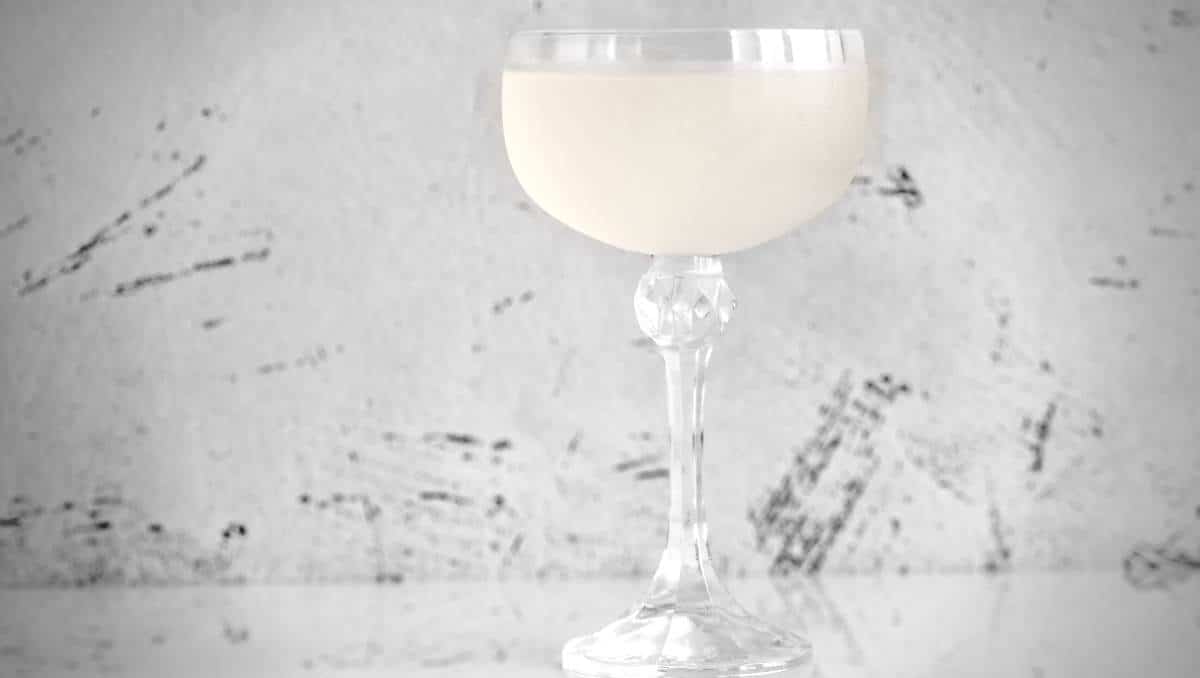
To me, the Bee's Knees cocktail is one of the best classic gin drinks. The blend of fresh lemon juice, honey syrup, and gin is simple, delicious, and dangerously easy to drink. It's sweet, sour, bright, smooth, and full of flavor.
As with most true classic cocktails, the history of the Bee's Knees is very foggy. There are many stories and legends about where who invented it.
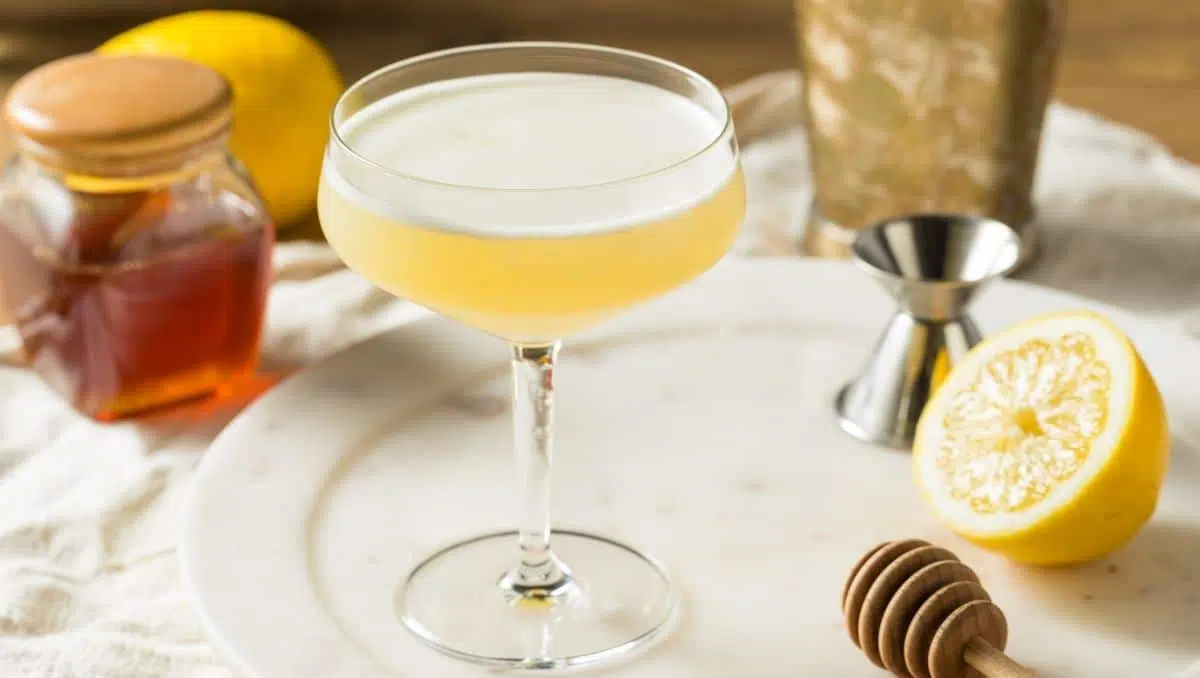
You need only three ingredients for the perfect Bee's Knees: gin, lemon juice, and honey syrup.
It's best to start with a ratio of 6:2:1.5. That means six parts gin, two parts fresh lemon juice, and 1 1/2 parts of honey syrup.
As close as the Bee's Knees recipe is to a Gin Sour, the ratios differ. The classic sour ratio of 6:3:2 does not work well in this cocktail. The result will be too sticky and sweet.
But this is just a start. If you like strong cocktails, you can increase the amount of gin. Should you prefer less boozy cocktails and like the tartness in drinks, increase the lemon juice. If you like sweet drinks, then, indeed, stick to the classic Sour ratio.
Basically, there are three more things to keep in mind: First, the is traditionally served straight up. That means with no ice. Thus, all ingredients, and the glass as well, must be chilled properly.
Put the coupe glass for 15 to 30 minutes in the freezer before preparing your drink, or cool it down with ice cubes while mixing. Remove the ice and the water from the glass before pouring your Bee's Knees.
Secondly, shake for a minimum of 15 seconds to ensure all ingredients are nicely chilled and to achieve the perfect dilution.
Last but not least, don't try to take a shortcut and use honey instead of honey syrup. Pure honey does not dissolve well in cold liquids, and you will end up with an unbalanced drink.
Although the recipe for the Bee's Knees cocktail is so simple and consists of only three ingredients, it is very versatile. Why? Two out of three elements can widely differ in taste, depending on your choice.

Let's start with what all sources seem to agree on: The Bee's Knees goes back to the era of prohibition. Most likely, somewhere during the late 1920s... And that's it. That's already everything where the stories and legends add up.
For a very long time, people said that the Bee's Knees' roots are in America. Allegedly, it was an attempt to cover up harsh and unpleasant notes of low-quality gin made in bathtubs during prohibition.
That story makes a lot of sense because the mix of honey and lemon juice is a great combination to do so. Nevertheless, over time, this belief changed. Now, most cocktail historians think that the Bee's Knees, most likely, did not originate in the US but in France.
The currently most told story on the history of the Bee's Knees is coming from the Ritz Hotel in Paris, France.
In the late 1920s, Frank Meier -an Austrian bartender- supposedly created the first-ever Bee's Knees cocktail. While his drink was still close to the original Gin Sour recipe, replacing simple syrup with honey syrup brought a next-level richness to it.
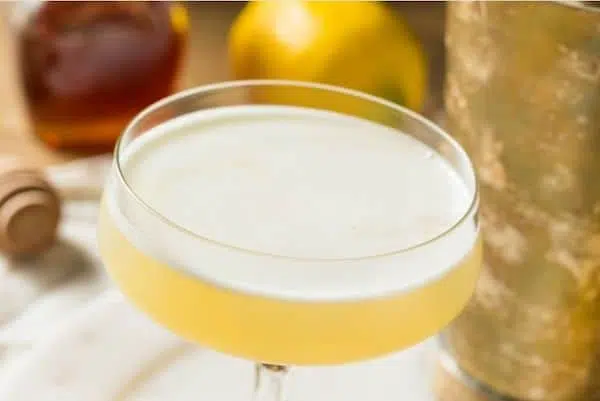
While many agree on the Ritz Carlton story above, there's now one more possible view. Authors and cocktail historians Jared Brown and Anistatia Miller did their own research. And the result of it is interesting.
The first-ever mention of the cocktail they found is also from Paris. Here, the credit goes to Margaret Brown, better known as unsinkable Molly Brown.
And no doubt, Margaret Brown had one incredible life. The famous Philanthropist and Socialite even survived the crash of the Titanic - hence the byname unsinkable.
Margaret Brown and Frank Meier likely knew each other. At the time, both were part of the core of Paris' high society. According to Brown and Miller's research, Molly Brown often served the creation at her parties in Denver and Paris.
So it's possible that she invented the cocktail herself and taught Frank Meier. Or, it was the other way around, and she loved Frank's creation so much that she served it as a regular cocktail at her parties.
Now that you have some delicious honey and homemade honey syrup at home, how about mixing up some other cocktails, as well?
The currently most told story on the history of the Bee's Knees is coming from the Ritz Hotel in Paris, France.
When making cocktails, the usual way to sweeten your drinks is simple syrup, but there is a fantastic alternative: Honey syrup!
Honey is mainly known for sweetening hot drinks like tea. That is because it needs heat to dissolve. In chilled drinks, it does not blend well due to its thick consistency. Fortunately, there's a workaround to help with that.
Our honey mix will bring this delicious flavor to your cocktails and blend perfectly with all ingredients.
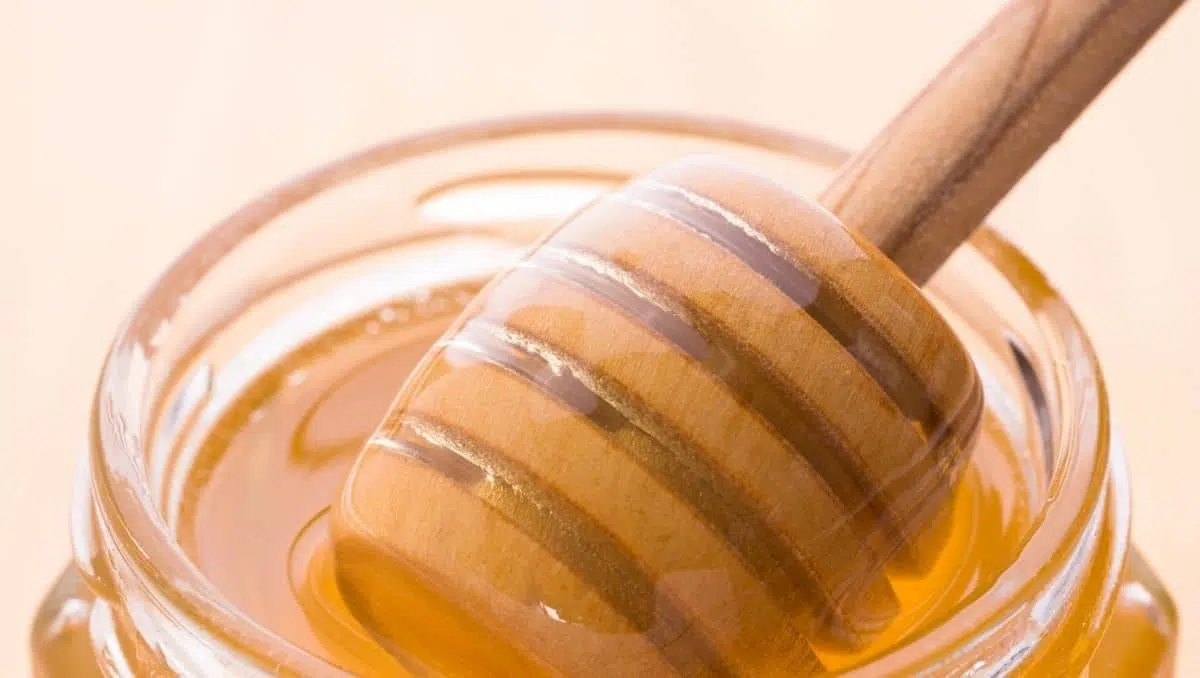
When making honey syrup, we only need two ingredients - water and honey. The standard ratio of the two elements is 1:1. If you prefer a more intense honey flavor, a ratio of 2:1 or, even 3:1 is possible.
However, remember that you trade the intensity of the flavor for a less soluble syrup. I recommend not going beyond 2:1 if you intend to mix cocktails with it. Generally, the traditional 1:1 approach will do the trick.
Making honey mix is pretty straightforward. Get the required tools and ingredients - honey, water, a saucepan, a fine strainer, and a sealable bottle - and you are good to go.
Stir while the mix heats up, and keep stirring until the honey has fully dissolved. Then, let the syrup simmer on low heat for another 5 minutes and remove the saucepan from the stove.
Once your honey simple syrup is cooled down, bottle it with the help of a fine mesh strainer to ensure there are no lumps.
You can store homemade syrup in the fridge, but, personally, we keep our honey mix at a cool place but not in the fridge. However, technically, if you keep it in a sterilized bottle, you can also store it at any room temperature.
The advantage of keeping it at room temperature is that the consistency is more runny, and you can use your honey syrup without any delays. When keeping your honey mix in the fridge, it gets thicker, and you might need to let it warm up a little before using it.
Honey mix with a higher ratio of honey will crystallize quickly in the fridge, so keep that outside in any case.
You can add more flavor and aroma to the syrup by incorporating sprigs of rosemary or thyme. Remember that the herbs should complement the honey you chose.
Another way to flavor honey syrup is to replace water with tea. Think of using chamomile tea or hibiscus tea. That can create a beautiful twist to an already delicious cocktail sweetener.
With every cocktail, you have to balance flavors. So, when using honey syrup, it makes sense to think about which type of honey fits best:
Check if the flavor of the honey will work with the other ingredients in your cocktail. For this, taste it pure without watering it down.
To get started, I recommend using Clover Honey. It's widely available, mild in flavor, and extremely versatile. Perfect for some experiments with honey syrup in cocktails.
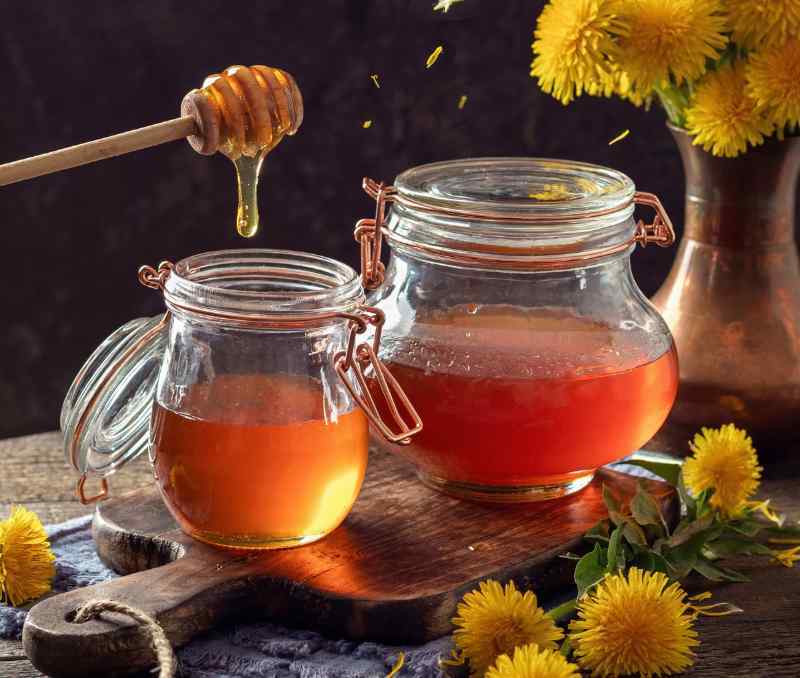
Other suitable options are:
Many delicious cocktails contain honey mix. Two of the most popular classics are the Bee's Knees Cocktail and a variation of it, the Gold Rush. And there are more exquisite recipes that call for honey syrup:
No, honey and honey syrup are definitely not the same. Honey syrup is a mix of water and honey, also known as honey mix or liquid honey.
As mentioned before, due to its viscosity, pure honey should not go into cold drinks like cocktails. So we need to water it down to make it thinner and easier to work with.
From the color-changing butterfly pea syrup to banana syrup and molasses-heavy demerara syrup, the options and variations of homemade syrups for cocktails are endless. Among our current favorites are:
The Mojito is one of the most famous rum cocktails today. The simple recipe with the memorable name has a long history and is known by people in every corner of the world.
Quick Facts Mojito Cocktail
Despite the original recipe being so simple, many versions you get are quite a poor take on it. They don't use enough mint leaves or sugar syrup instead of granulated brown sugar and just don't give the Mojito the love it deserves. So, this Cuban cocktail needs a little attention to detail, and we show you how it's done:
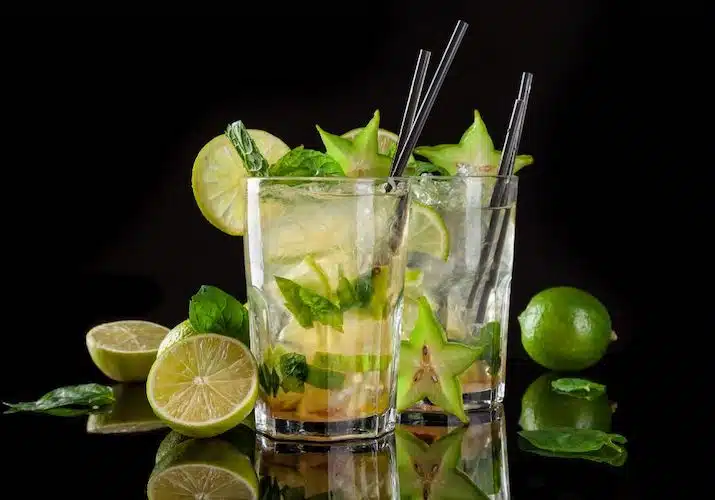
For making a fantastic Mojito, it is essential to use quality ingredients. So here's what you need:
As mentioned, simple syrup does not belong in a classic Mojito cocktail. It might be okay to substitute sugar with syrup for many other cocktails. But not here because this drink needs the flavor and the texture of actual sugar.
Further, be picky regarding which sugar you use. That means no regular white or brown sugar and definitely not superfine or powdered sugar.
The best option is granulated cane sugar. That, by the way, is the original ingredient to many Latin American Rum cocktails. It adds the caramelly, rich flavor an amazing Mojito needs.
If you want to get something special, try Demerara or Turbinado. Those two are less refined and add plenty of flavor to your Mojito cocktail.
Mint is the secret star of every Mojito. Slap it gently before prepping the cocktail to release its essential oils. Also, these two varieties work best:
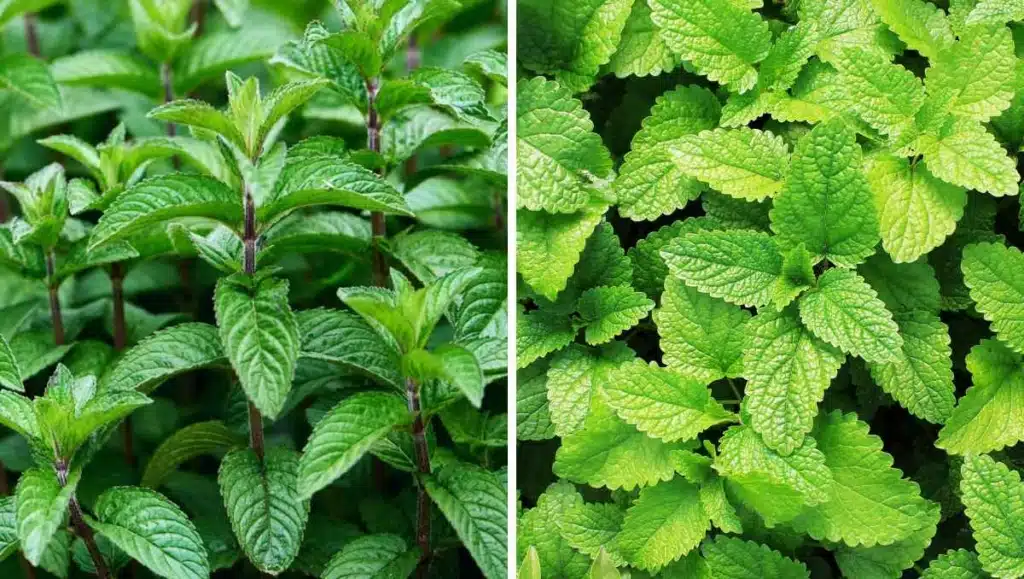
Now, you need ice, a Highball glass, a cocktail shaker, and a juicer. Also, press and roll the limes before juicing them. That softens the flesh and makes your life a lot easier when squeezing them.
Add Mojito mint, lime juice, and cane sugar into a cocktail shaker. Gently muddle to dissolve the sugar and release the flavor of the mint but do not rip the leaves into tiny pieces.
Fill the Highball glass with crushed ice or ice cubes and add additional mint leaves (slap them before using them for an intense aroma). Remember not to use crushed ice for shaking, though, as this will water your Mojito down too much.
There are plenty of Mojito variations out there worth trying - some more basic, some more adventurous. Most have one thing in common: they add fruit. Four of our favorites of these fruity twists are:
There are many stories and anecdotes of how the Mojito came to live, some involving Sir Francis Drake, others American Indians, and others again think it was slaves who first mixed a similar concoction.
All these tales have in common that they tie the drink to Cuba. The recipe, as we know it today, probably goes back to the mid-1800s. Check out our article on the history of the Mojito Cocktail to get all the details.
For more minty cocktail delights, try some of these recipes:
Chamomile is a small, white, and unassuming flower that's often growing in gardens and flower fields all across the globe. It's famous for its medical benefits and is commonly used for brewing tea.
But chamomile can also be a superb addition to other drinks besides tea. For instance, it works in lighter summer drinks.
Chamomile cordial brings in herbal notes, sweetness, and the slightest hint of bitterness when mixed in a Spritz cocktail.
You can also try it in the Ve.n.to cocktail. -Actually, it calls for chamomile liqueur. However, as the liqueur is often hard to get, cordial can work as a replacement and creates a less boozy version.
When used in cocktails, bartenders often opt for chamomile in form of a cordial. That way, the drink is not only flavored but also sweetened at the same time.
Read on, and let me show you how you can make your own chamomile cordial at home.
Although many think there's only that one kind of chamomile, in reality, there are many different types and versions of the plant.
A total of eight different plant types run under the name chamomile inside the plant family of the Asteraceae.
Usually, German chamomile (Matricaria chamomilla) and Roman chamomile (Chamaemelum Nobile) are the sorts we find in teas and other herbal infusions. Also, only the flowers of chamomile are used.
In some cases, chamomile is also a component in the brewing process of beer. It adds some bitter flavors to the brew. And in that case, not only the flowers but the whole plant is processed.
Cordials are pretty similar to syrups. In fact, a cordial is a syrup infused with herbs, spices, or other kinds of plants.
That's also why you'll find a vast selection of different cordial recipes, making it a perfect base to experiment with all kinds of cocktail recipes.
And cordials are not only a great addition to boozy cocktails. They are also excellent for adding flavor to mocktail recipes. And if you prefer it without any frills: it is also a nice refreshment when mixed with plain club soda.
Chamomile can be beneficial for a variety of health issues. It's commonly used as medication when you have a cold. And chamomile is also helping with reducing inflammation.
But have you ever heard that it also lowers your blood sugar, improves your quality of sleep, and helps to prevent & fight cancer?
A study from 2012 by Serbian Scientologists even poofed the effect of marigold and chamomile teas targeting cancer tumors.
Although I have to add that, apparently, the results for Marigold were better than that of chamomile. -Please note that this can always only be supporting treatment and never replace medical therapy.
Chamomile is the classic herb for use in teas and does have a reputation of being rather unexciting.
Let's change that and turn it into a fancy cocktail ingredient in making chamomile cordial. And doing this isn't hard at all.
All we need is sugar, water, chamomile, and a bit of citrus peel. And the result will add a beautiful herbal chamomile note to your cocktails. So let's get started with our cordial.
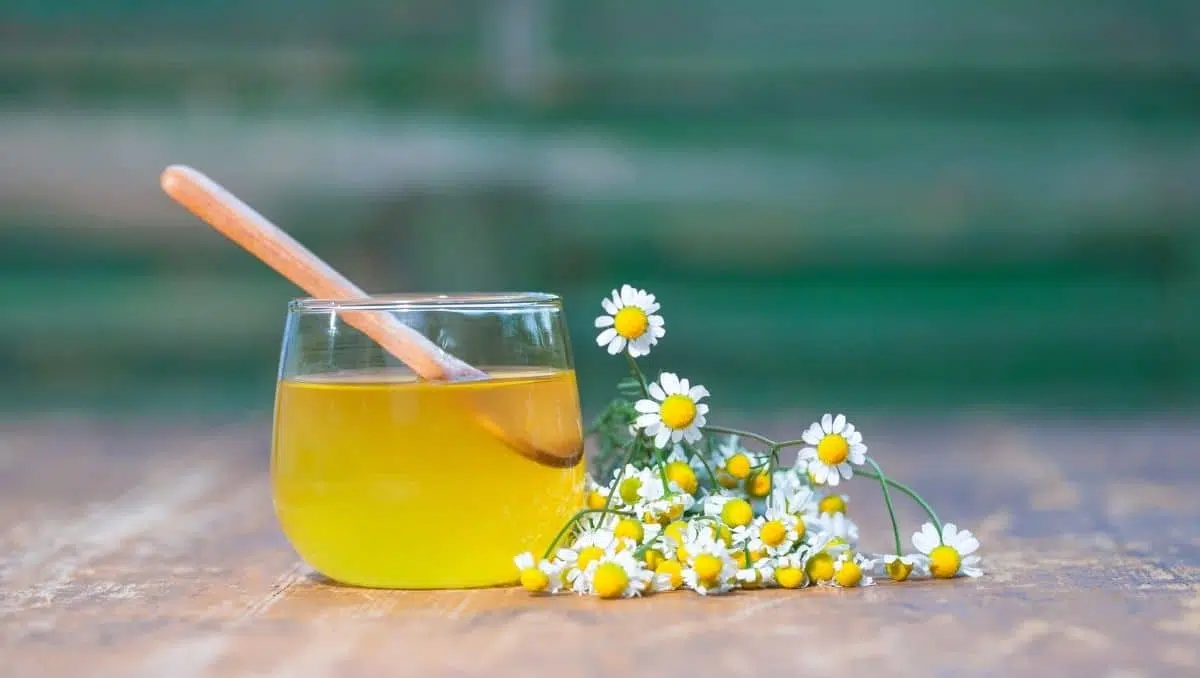
In its early days, the Clover Club Cocktail was only available to a few selected people in Philadelphia. But it evolved into a drink every bartender should know and be able to mix.
The raspberry cocktail has a quite unique flavor profile for such a classic drink: sweet, sour, and fruity flavors dominate this delightful cocktail.
Quick Facts Clover Club Cocktail
Read on to learn about the history of the cocktail and how you can make it to perfection at home.
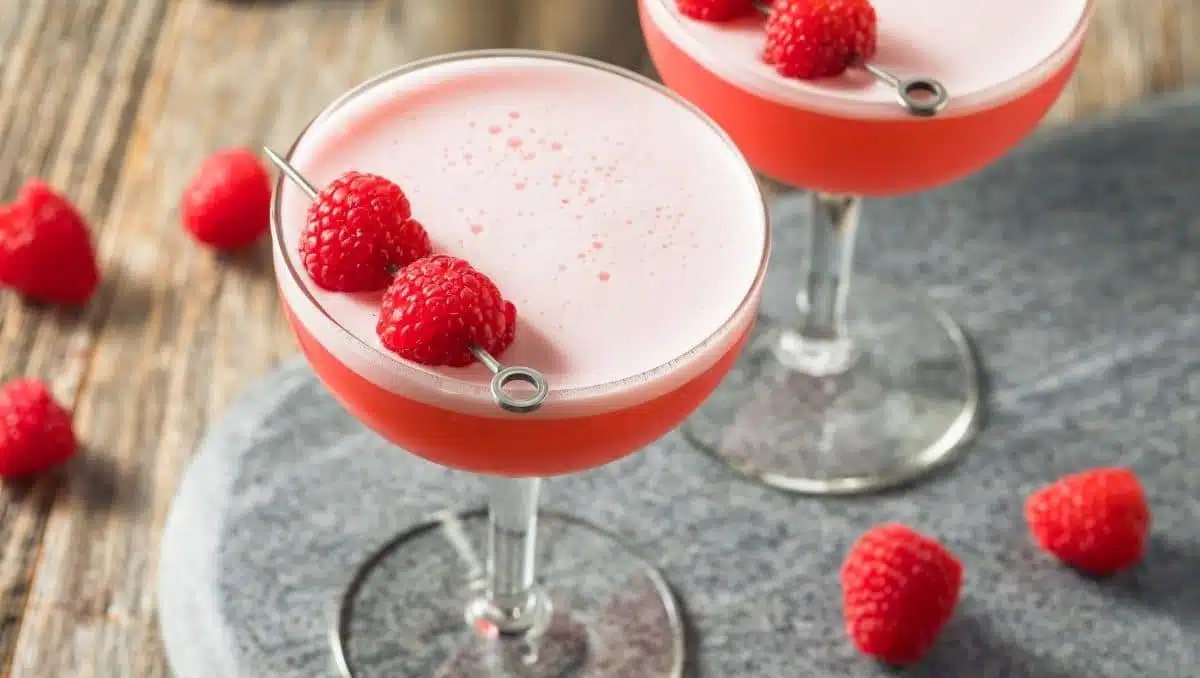
The Clover Club recipe calls for five ingredients: gin, freshly squeezed lemon juice, Dry Vermouth, raspberry syrup, and one egg white.
The Clover Club recipe asks for egg white because it gives the cocktail a velvety texture and creates a beautiful foamy top.
Many cocktails recipes include egg white as an optional ingredient, but the Clover Club is not one of them. There is absolutely no way you can achieve the required creaminess and characteristic look of the cocktail without a foamy ingredient.
Yet, if you don't want to use raw egg white in your drinks, there's a vegan alternative called Aquafaba.
Since you want a thick and consistent foam on top, one of the top tips is to perform a dry shake. That means shaking all ingredients without ice for about 20 seconds and then shaking them a second time with ice (wet shake).
Now, if this technique does not get you a decent foamy top, consider reverse dry-shaking. Here, you first shake with ice, then remove the ice with the help of a cocktail strainer and shake again.
We advise only to do this if a regular dry shake doesn't work for you because it takes longer. And more importantly, your Clover Club Cocktail is not as cold as it could be.
Having said that - regardless of whether you dry or reverse dry shake, you should chill your coupe glass before mixing & pouring your cocktail. Since you serve the Clover Club without ice, this helps keep its contents at a low temperature for longer.
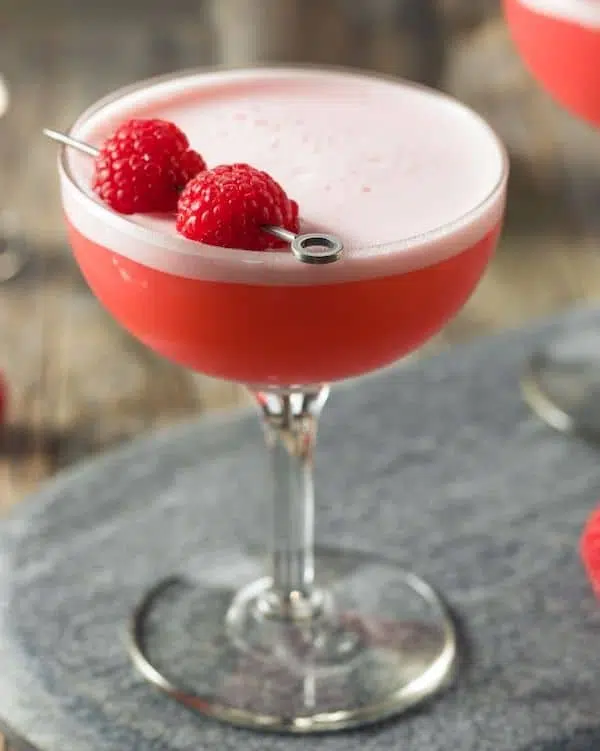
The raspberry syrup is the element most suitable for twists and tweaks. Basically, you have two options that still maintain the overall character of the Clover Club:
There are claims that the original recipe included grenadine instead of raspberry. However, despite some recipes asking for grenadine, it wasn't, in fact, part of the original recipe. -And it certainly isn't the best way to make this cocktail. Grenadine is too heavy, and most importantly, does have no raspberry flavor.
Clover Club was the name of the Gentlemen's Club in the Bellevue-Stratford Hotel, where the cocktail was invented. So, the newspaper that mentioned the Clover Club cocktail for the first time in writing in 1901 simply took the place of origin as a reference. And the name stuck.
The cradle of the Clover Club lies in Philadelphia in the late 1800s. There, in the Bellevue-Stratford hotel, a selected group of men got together regularly to discuss current problems in the world.
Most of them were working in legal, business, and literary professions. Thus, the hotel was a Gentlemen's club that brought the male upper class together to talk and share a few drinks.
It was here that the Clover Club had been shaken and served for the first time sometime during the 1890s. For years, the cocktail was exclusively available to club members.
However, things changed when George Boldt, the former hotelier of the Bellevue-Stratford, moved to the prestigious Waldorf-Astoria Hotel in New York City. Together with him, the recipe for the cocktail arrived in New York City and was written down for the very first time:
The New York Press published its take on the drink as a mix of gin, lemon juice, sugar, raspberry syrup, and egg white. And the cocktail was a huge success. People just loved the unique distinct flavor and the unusual way of mixing up a drink. Yet, after the initial hype, the fame of the Clover Club drink faded.
First came prohibition and then, In the 50s, the fruity cocktail was suddenly disparagingly referred to as a "Lady's drink" by whiskey-loving businessmen. Once the era of soda guns and pre-made sour mixes began, the cocktail vanished almost completely. The craft cocktail era was over. Simple-to-make drinks were in!
Luckily, times are ever-changing, and old trends do come back. The craft of making cocktails with fresh and quality ingredients is as present as it has ever been. And with it, the delicious raspberry drink celebrated a remarkable comeback.
Some people believe there is only one Maraschino liqueur and get confused when they see different brands on the store shelves.
In a way, that thought is not entirely wrong, though. In the beginning, there were only a handful of producers for Maraschino liqueur. And of those, only Luxardo stayed in business until today and is therefore viewed as the original.
While Luxardo still is the most popular and doubtlessly one of the best brands to sell Maraschino liqueur, you can find quite a large selection of this cherry liqueur in liquor stores today.
What is it? | Facts | Marasca cherries | Taste | How to drink | Cocktail recipes | Best brands | Substitutes | History
Maraschino is a clear, high-ABV liquor made from cherries. The thing is that Maraschino is not a brand name. Instead, it refers to its main ingredient, the Marasca cherries.
This indispensable ingredient is growing only on the Dalmatian coast of Croatia. So, let's find out more about the liqueur, the Marasca cherries, and how Maraschino was invented.
Marasca cherries, sometimes also spelled maraska, have a dark red color, are small, quite firm, and astonishingly sour. Their origin lies in the coastal regions of Croatia, in the Dalamatia region, to be precise.
So, besides the famous dog breed, these cherries are probably the best-known export from there.
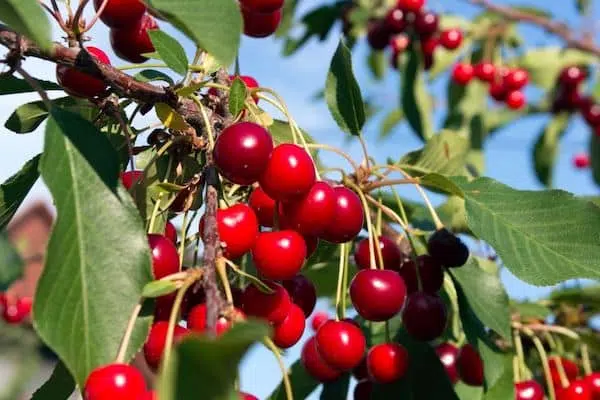
The name marasca is derived from the Italian word amarasca and is related to the Italian term amaro, which translates to "bitter". And indeed, besides being smaller and a lot darker than other cherries, the marasca is very bitter. That characteristic makes them a perfect base for a liqueur, as they won't make the end product overly sweet.
Maraschino liqueur does have a slight cherry flavor. Yet, first and foremost, it is bitter, slightly dry, and also carries notes of almonds. The almonds are particularly detectable when drunk neat.
Even though it's a liqueur and, therefore, does contain a degree of sweetness, it's far less sugary than the average. The exceptional bitter-dry flavor profile is celebrated all over the world. And this unique combination is also why you'll find this in many classic cocktail recipes.
It's one of those essential cocktail ingredients your home bar should always have in stock.
Maraschino is famous for its combination of dry and bitter. Together with the subtle sweetness and the cherry flavor, it makes for an excellent digestif. Served straight on the rocks, Maraschino liqueur is simply a delightful sip.
Yet, it is for a good reason that it mainly became famous for its use in cocktails. As a matter of fact, some of the most iconic drinks in cocktail history are made with Maraschino.
The reason is simple: It adds a delicately sweet and fruity note of cherry without being overly sweet. And it pairs extraordinarily well with many different spirits like Whiskey, Gin, Rum, or Brandy.
Numerous cocktail recipes require Maraschino. The delicious almond-cherry flavor and the slight sweetness make it a staple in any home bar. Some truly iconic cocktail recipes ask for the cherry liqueur, and here's a list of our favorites:
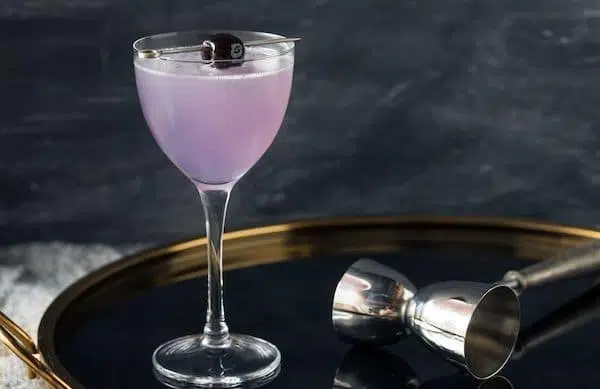
Luxardo is, without a doubt, right on top of that list. It has a history that goes back more than two centuries, and the renowned producers know what they are doing.
However, the number of brands joining the market grows constantly, and there is quite some worthy competition. All have their own recipe with an individual set of ingredients, so you might want to try some of these to find your favorite:
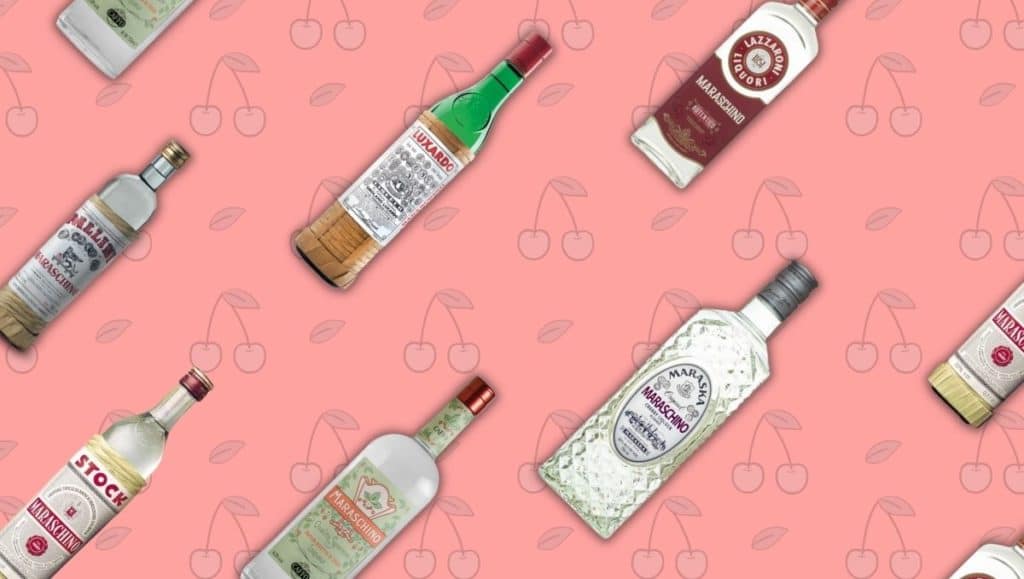
As unique as this marasca liqueur is, you still can find some products you can use to substitute it. Yet, keep in mind that each has its own flavor profile, which will impact your final results. Despite the similarities, some are quite a stretch from the original.
Cherry Heering is another famous cherry-flavored liqueur. It's part of the iconic Singapore Sling cocktail and originally comes from Denmark.
While Maraschino is clear, cherry Heering has a bold red color. Overall a good substitute but significantly sweeter than the original.
Another option to bring cherry notes to your drink is cherry Brandy. A lot less sweet than Heering, it adds a typical Brandy taste to your cocktail. That works well in some cases but the oaky notes do not fit every recipe.
Amaretto is another also from Italy known for its strong almond taste. It lacks the cherry notes, but occasionally the almond-flavored liqueur can make for a decent substitute.
If you're looking for an alcohol-free alternative, try cherry syrup. If you want to keep it as close to the original as possible, consider getting marasca syrup or making your own at home.
As early as the 1700s, Francesco Drioli, an Italian merchant from Venice, began to produce Maraschino liqueur on a larger scale. The place of production was Zadar, today part of Croatia, but back then, it belonged to the region of Venice.
It didn't take him too long to gain recognition, as his product was famous in Europe by the end of the 18th century. And after Drioli successfully made the liqueur popular, others began establishing their own production. One of them was Girolamo Luxardo, now the best-known brand for Luxardo was also part of the "Maraschino industry of Zadar", founded by Francesco Drioli.
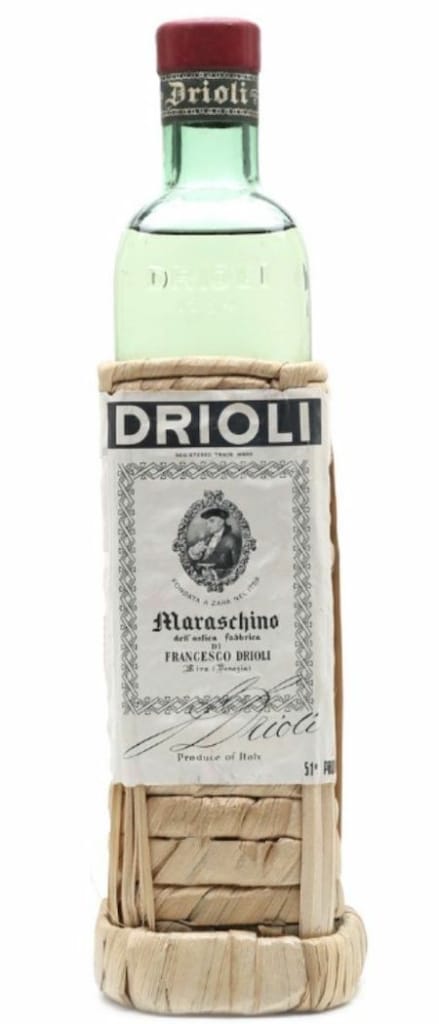
After the Second World War, the bombing of Zadar, and other dire events, the three most important Maraschino producers moved their factories across the border to Italy. Amongst them were the ones from Drioli and also Luxardo.
And while Drioli made Maraschino famous in Europe, Luxardo played a vital role in bringing the cherry liqueur to the attention of worldwide customers.
Rum & Coke is one of the most popular long drinks in the world. The unpretentious Highball is a smooth mix of sweet flavors chilled, served over plenty of ice.
The refreshing cocktail is delicious and easy to prepare, and with our recipe, you get more than just an average mix of Rum and Coke. That includes getting the ratio right, choosing the best rum, using enough ice, and choosing the best Coke to go with your rum.
Quick Facts Rum & Coke
Hang on and read all tips to make the perfect Rum & Coke.
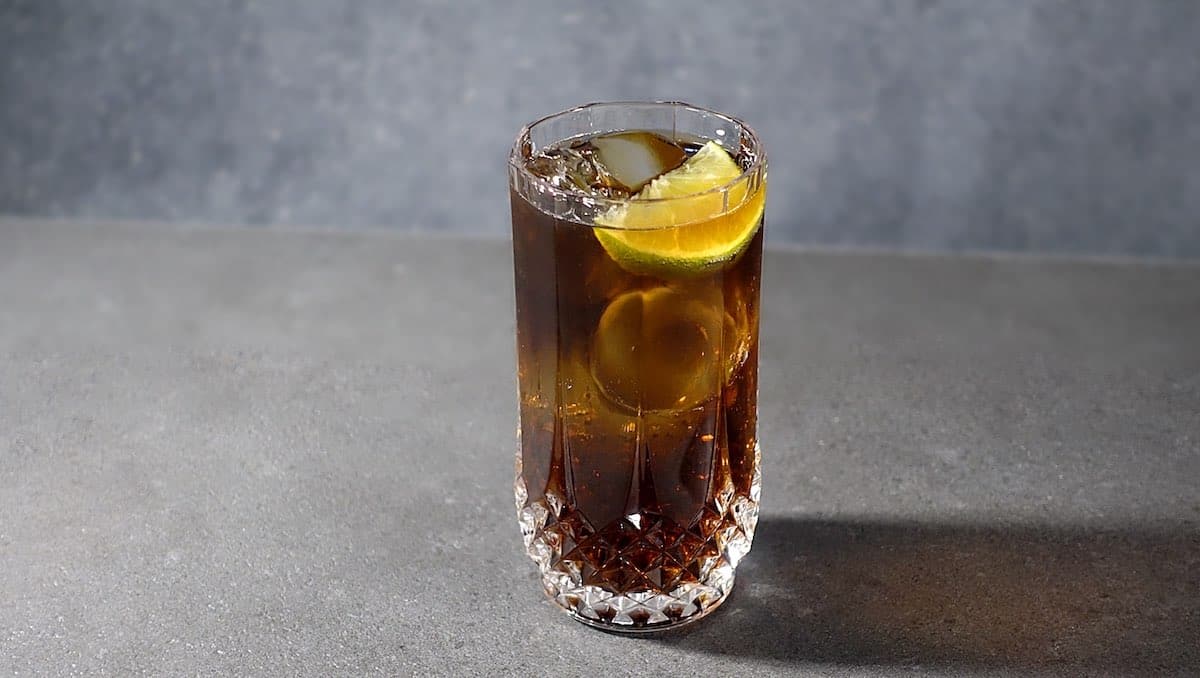
Above all, and as with every Highball recipe, the quality of ingredients matters. As long as you go for decent quality, you can basically use any type of rum - aged, unaged, spiced, etc., in a Rum & Coke.
Which one is best entirely depends on individual taste. However, you're probably not here for a generic answer like that. So if you don't have favorites, that answer won't help. Thus, we will tell you which rum we prefer in our Rum & Coke.
Getting straight to the point, between the different types of rum and overall, we like an Añejo best for my Rum & Coke. It's rich, full-bodied, and sweeter than unaged rum.
To give you an idea of the differences, here's a short summary of the different types of rum with recommendations:
White rum is a clear and unaged version. It's what you usually get in cocktails. The flavors of white rum are crisp, clean, and fresh.
Our recommendation for the best white rum in this Highball would be Flor de Cana 4 years Extra Seco. It is refreshing, crisp, affordable, and ideal for hot temperatures.
gold rum is slightly aged, thus richer and warmer than white rum. These more robust flavors shine through when mixing them with Coke.
It is quite similar to dark or aged rum. The main difference is that it contains additives like caramel, which work nicely with Coke. My recommendation is Gosling's Gold Seal Rum.
Aged rums, especially long-aged, offer a broad and exciting flavor profile. Often intended to be sipped neat on ice, the complex flavors of barrel-aged spirits make a very smooth Highball when mixed with Coke.
When choosing the right one, your usual long drink can taste like a carefully crafted cocktail. My recommendations for a dark rum are El Dorado 8 Years or Havana Club Añejo 7 Years.
Overproof rum contains around 60% alcohol by volume, some even more than 70%. The result is a very potent drink. If you want to give overproof rum a try, Smith and Cross Navy Strength Rum is a great way to start.
Spiced rum is a special category. Nutmeg, vanilla, and cinnamon are common ingredients to spice rum. Some people don't like that at all in Rum and Coke due to the high level of sweetness. Others swear by it, though.
A pro tip for a spiced Rum & Coke is to put the rum in the freezer before using it. The sugar will start to crystalize and create a fun effect when mixing it with Coke. Personally, I like the Kraken Spiced Rum for this.
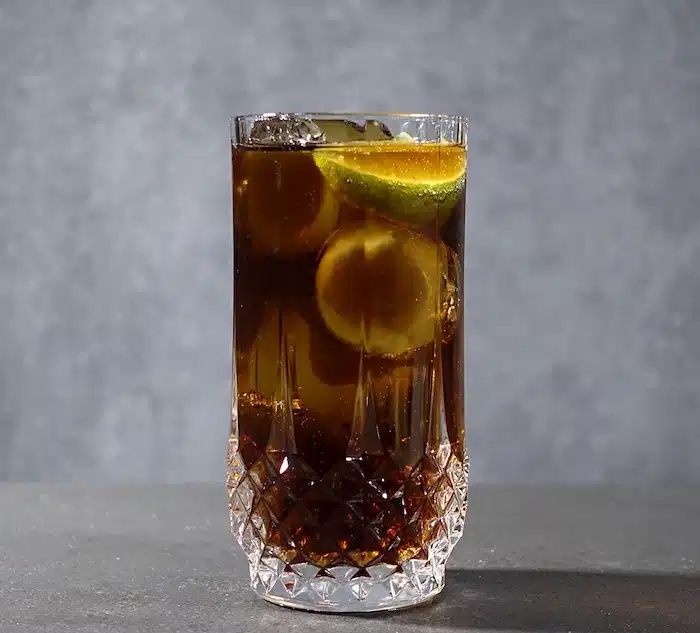
The perfect ratio of Rum and Coke is between 1:2 and 1:3. As it is a classic two-component recipe, proportions are essential for getting things right. And it is also about using enough ice.
I suggest you start with a Highball glass and fill it to the rim with quality ice. Pour in 2 ounces of rum followed by 4 ounces of Coke. That means you start with a 1:2 ratio. From there, you can gradually increase the amount of Coke until the drink is perfect for you.
As a rule of thumb, the higher the quality of your rum, the less Coke you will need. Generally, in a recipe based on white rum, your ratio should be more like 1:3. In a version made with aged rum, you're better off with a 1:2 approach.
The Coke part also has an impact on your drink. However, we don't want to start the obligatory Pepsi vs. Coke debate. -We definitely prefer Coke. No, we are talking about the differences between Coke from the US and from Mexico.
Have you ever been to Mexico and tried a Coke there? Did you notice a difference? Well, you should because American Coke is sweetened with corn syrup, and the Mexican version contains sugar cane.
Due to that small change, the Mexican version is way smoother, less sugary, and has almost no aftertaste. The fact that both, Mexican Coke and rum, are made with sugar cane is a plus, too.
You can get Mexican Coke in Hispanic supermarkets or order online.
Ice does make a huge difference in your highball. So you want to use plenty of large and crystal clear cubes. The higher the quality of your ice, the slower it will melt and the longer the fizz will remain in your drink.
To elevate your Rum & Coke further, add just a squeeze of fresh lime or lemon juice. The citrus notes will cut through the sweetness and create a more balanced drink.
You are looking for cocktails made with Coke? Check out some more of our cocktail recipes:
Also, if you want to know what to mix next with that bottle of rum, here are our favorite Rum Cocktails.
The city of New Orleans is famous for various recipes beyond the Sazerac. Classic cocktail recipes like the Ramos Gin Fizz, Vieux Carré, and the Brandy Crusta all originated in New Orleans.
However, the most famous of them still is the Sazerac cocktail. It is not only popular among bar patrons, but it also has an interesting history; -or actually, two histories.
As with many cocktails, the origin is somewhat unclear. However, in the case of the Sazerac, a variant of the story is largely invented. Learn more about New Orleans's official cocktail and how it really came to life.
The preparation of this drink has its own name: the "Sazerac" style. That usually describes how the glass is rinsed with Absinthe before pouring the cocktail. But let's have a look at this step-by-step.
Step 1: Fill a rocks glass with ice cubes and set it aside.
Step 2: Add sugar cube to mixing glass and muddle with bitters and half a teaspoon of water.
Step 3: Add ice cubes together with Sazerac Rye and stir the drink until well chilled.
Step 4: Discard the ice cubes from the rocks glass and pour in the Absinthe. Rinse the glass with it. Discard any excess Absinthe.
Step 5: Strain the drink into the rinsed glass and garnish with a lemon twist.

Over the years, the Sazerac cocktail has seen a few changes to the original recipe. So it is not surprising that today there are countless variations and riffs of the classic recipe.
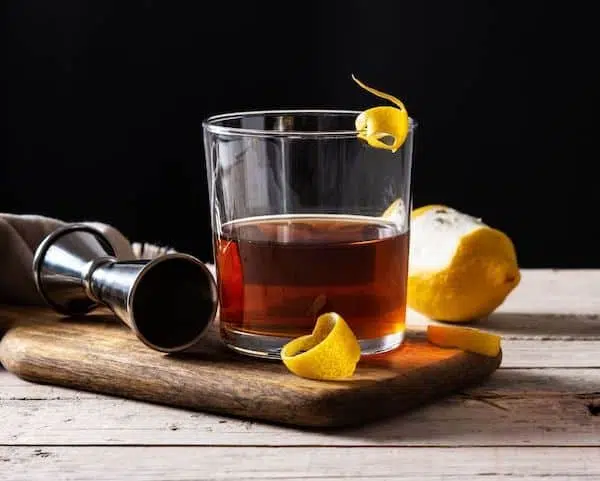
There are many drinks with an unclear history. With the Sazerac, for a long time, historians thought the story was straightforward: A man named Stanley Clisby Arthur made the world believe that Antoine Amedée Peychaud, inventor of Peychaud bitters, also invented the Sazerac.
He embellished the story, mentioned the secret bitters recipe that Antoine Peychaud's family brought from Haiti, and claimed that Antoine had invented not just any cocktail but the world's first.
He created a complete lore with countless details and additional information. For example, the cocktail is said to have found a home in John B. Schiller's bar, the Sazerac Coffee House.
For decades, many believed the story to be true. In recent years, however, cocktail historians could prove that Stanley Clisby Arthur was merely trying to establish Peychaud's bitters as the original recipe of all bitters (which they aren't) while spinning a tale of why and how they came to be part of the Sazerac. [1]
If you leave aside the invented history and solely rely on proven facts, the drink's history looks completely different.
The first thing that stands out is that the Sazerac cocktail was not at the beginning of Sazerac Coffee House's fame. There are many mentions of the coffee house between 1871 and 1885 without a single word about the Sazerac cocktail. [2]
In 1895, Vincent B. Miret and Billy Wilkinson (business partners and head bartenders at Sazerac House) filed a trademark application for their bottled cocktails. The first time the actual Sazerac cocktail appears in writing is in an Alpha Tau Omega Palm report from March 1899.
As a funny side note, the Absinthe rinse, an integral and iconic part of the Sazerac recipe, wasn't that special at this time. Actually, the Absinthe-rines Sazerac was almost the same as the ubiquitous Absinthe dashed "Improved Whiskey Cocktail". [3] Even the addition of Thomas Handy's bitters, giving the drink a rosy hue, didn't help to distinguish the Sazerac from that drink.
So, back in the day, the recipe of the cocktail wasn't new and innovative but what stood out was the fact that Miret and Wilkinson put on a spectacular old-fashioned bartending show, the likes of which you could only experience at Sazerac Coffee House in New Orleans.
Sadly, both inventors of the Sazerac died shortly after, which is one of the reasons why the origin of the Sazerac is not known. Miret died back in 1899, and Wilkinson shortly after in 1904. [4] [5]
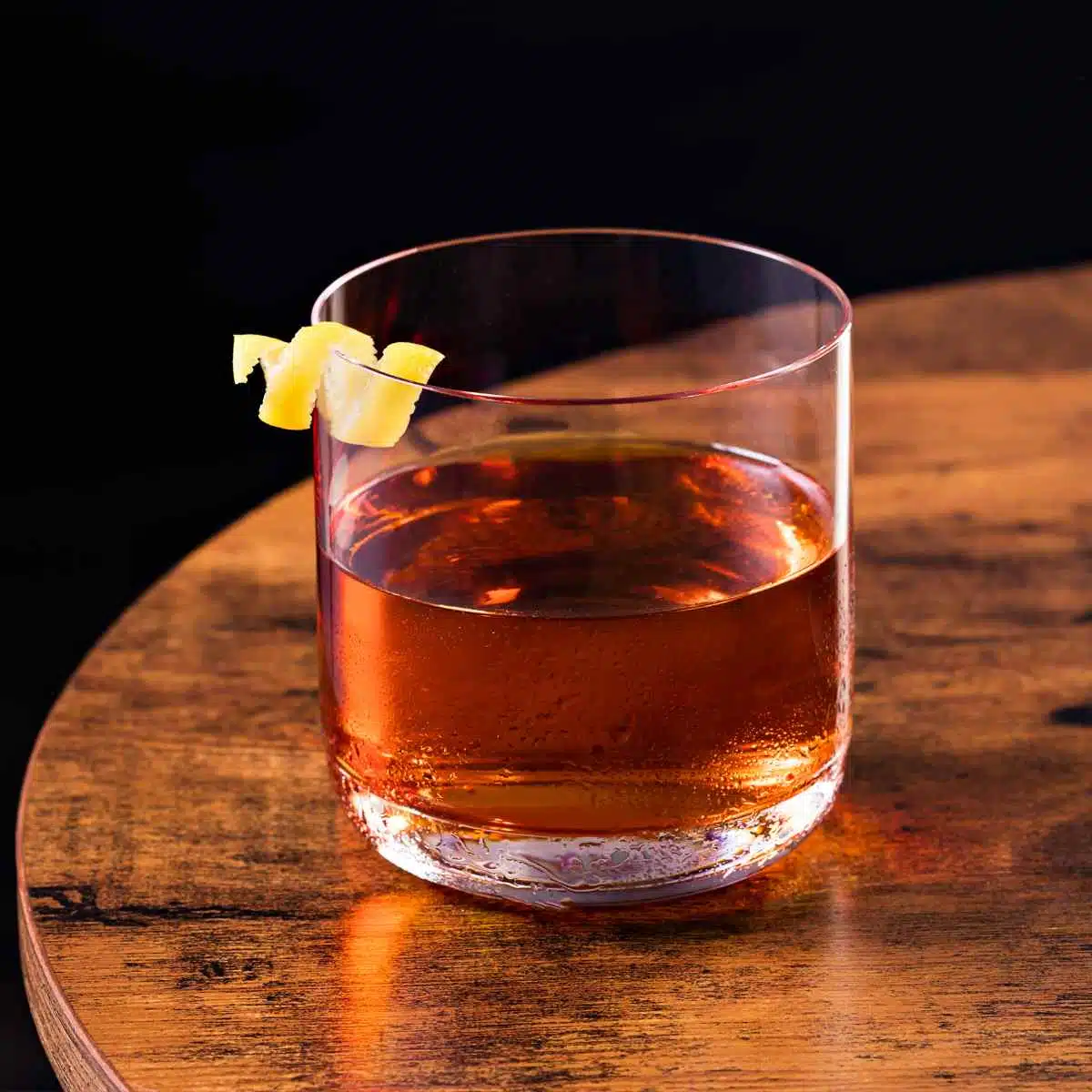
Rye is known for its spicy flavor profile, distinguishing the spirit from other Whiskeys like Bourbon, Scotch, or Irish Whiskey. Here are some popular cocktails you can make with Rye, except Rye Whiskey:
Tequila is a great spirit to sip or to mix into cocktails, that primarily depends on the type of tequila you're drinking. Each type differs in color, age, and taste. For example, an unaged Blanco Tequila is known for its bright and crisp flavor, making a Margarita cocktail so refreshing. An Extra Añejo, on the other hand, is best to sip neat at room temperature to indulge in the complex flavor profile the spirit developed during aging.
The United States is the number one importer of the Mexican agave spirit from Jalisco. In 2022, Mexico exported more than 393 million liters of tequila worldwide. More than 85% of it (around 338 million liters) went straight to its neighbor, the US.
Let's dive in and find out how the different styles and types compare.

The main types of tequila are Blanco, Reposado, and Añejo. But besides these three, there are more styles and types to discover. Yet, what are the differences between the various tequila types? Discover what sets the basic types of tequila apart.

Blanco Tequila is an unaged or slightly aged tequila that rests in stainless steel tanks or barrels for up to 60 days. This type is the purest version of tequila, also known as silver tequila or tequila plata, referring to its usually colorless appearance.
Blanco Tequilas are typically not your first choice as a sipping tequila, although you can find several bottles excellent for sipping. Instead, its bright and crisp taste is best in combination with lime juice or orange juice in classic tequila cocktails like Margaritas, Palomas, Tequila Sunrise, or Ranch Water. In fact, most of the best tequilas in Margaritas are blancos.
The flavor profile in a Blanco Tequila can vary a lot. Some may be more one-dimensional and agave-forward, while others have more complex flavor profiles, including flavors like citrus, pepper, spices, and vanilla.
If you're not used to the taste of this agave spirit, sipping a Blanco might not be enjoyable at first. However, if you get used to its bright taste, a Blanco can become an exciting type of tequila to sip.
Our recommendation for a Blanco Tequila: Fortaleza Blanco
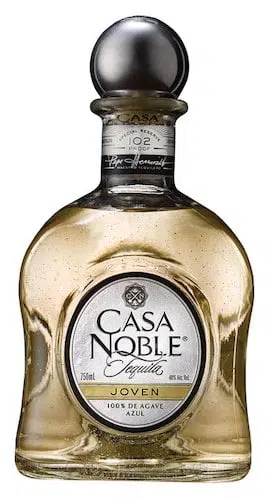
Joven Tequila is a blended tequila type produced by mixing aged and unaged tequila. The term Joven is the Spanish word for young and indicates we are not talking about aged tequila that matured for an extended time. Its characteristic amber color is the reason it's often called "Oro" or "gold" Tequila.
There are two different ways to achieve this amber color. In the best case, Joven Tequila is a blended mix of unaged and aged Tequilas. But unfortunately, most of the time you get a Blanco Tequila blended with added coloring and flavoring.
This resulting Gold Tequila is typically flavored with additives like oak extract, caramel coloring, glycerin, and others. In many cases, these bottles are mixto tequilas (see explanation below), tequilas distilled from only 51% agave sugars.
Our recommendation for a Joven Tequila: Casa Noble Joven Tequila
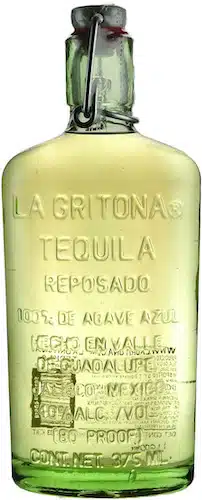
A Reposado Tequila (speaks: “reh-puh-saa-dow”) is an aged Tequila. After distillation, the spirit matures in oak or Holm oak barrels for at least 60 days and up to one year. Reposado tequilas have a darker, almost golden color, and the flavors are often sweeter than in a Blanco, with notes like warm cinnamon, spices, vanilla, honey, and nuts.
Reposados can be great sippers but don't necessarily have to be. Instead, they're an excellent alternative to Blanco Tequilas in cocktail recipes. Their sweeter and more mature taste turns the flavor profile into a more complex and mellow version of the drink.
Within this tequila category, there's an immense variety. Some bottles are barely different from Joven Tequilas, while others stay in the barrel for almost a year and are quite close to the flavor profile of an Añejo Tequila.
Our recommendation for a Reposado Tequila: La Gritona Reposado Tequila

Añejo tequila ages for at least one year in French oak barrels. The term "Añejo" printed on the label of bottles translated to "old."
If we compare that to whiskey or rum, aging for one year would by no means qualify as old. But in the world of tequila, it does. That is not least due to one major disadvantage Tequila producers have:
Agave plants (maguey) take almost a decade to grow before one can harvest them. That's a lot of time and effort already going into the product before it even exists. You may say that agave spirits mature before they're even produced as the plants give the spirit its distinct taste.
The barrels used for aging are often former whiskey barrels with a maximum size of 600l. Once filled, the sealed casks are set aside for one year or more. Age then gives the beautiful dark amber color to the tequila, while it also develops complex flavors and aromas.
The taste may vary from okay and spicy to warm and sweet, with a buttery texture and hints of vanilla. That makes the Añejo type perfect for sipping neat or on the rocks, just like other brown spirits.
Our recommendation for an Añejo Tequila: Herradura Añejo Tequila

Extra Añejo is a premium tequila type, aged for at least three years in the same barrels as Anejo Tequila. This type is relatively new and evolved due to the rising popularity of the agave spirit and the growing demand for aged premium spirits.
It was first released in 2006 and quickly became very popular. The main reason is that aged tequila develops very intense, deep, and intriguing flavor profiles with notes of dark caramel, chocolate, cinnamon, and vanilla. There are some top-shelf Extra Añejo Tequilas that are comparable to fine cognacs in terms of complexity - and also in price.
The first time I tried an excellent Extra Añejo Tequila, I was blown away by its taste. Should you want to share the experience, it was a glass of Jose Cuervo's Reserva de la Familia. Certainly not cheap, but it is worth its price tag.
Our recommendation for an Extra Añejo Tequila: Jose Cuervo Reserva de la Familia
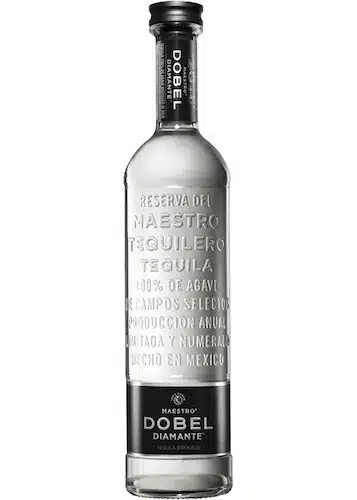
Cristalino Tequila is basically an Añejo Tequila that's charcoal filtered or re-distilled after aging in barrels to remove the dark color. These aged, filtered tequila types will not only lose the color obtained from barrel-aging but also most of their flavor due to losing tannins.
In return, a Cristalino tastes much lighter than a classic Añejo and has pronounced floral and fruity notes. The result is a clear Tequila that somewhat lost its identity. It's somewhere in between Blanco and Añejo.
The Cristalino type is officially recognized by the Tequila Regulatory Council, but not yet listed as an official category of tequila like the five types above. However, it seems this is just a matter of time at this stage.
Our recommendation for a Cristalino Tequila: Maestro Dobel Cristalino Tequila Diamante
Tequila Curados are a blend of tequila and natural ingredients like fruits. Typical flavorings are lemon, lime, orange, strawberry, and pineapple.
Tequila Curados only need to contain 25% agave during the fermentation process. That's even a lot less than a mixto tequila needs. The fact that additional sweeteners, coloring, and flavors are allowed makes this type very debatable. According to the standard, up to 7.5% can be "non-traditional" ingredients.
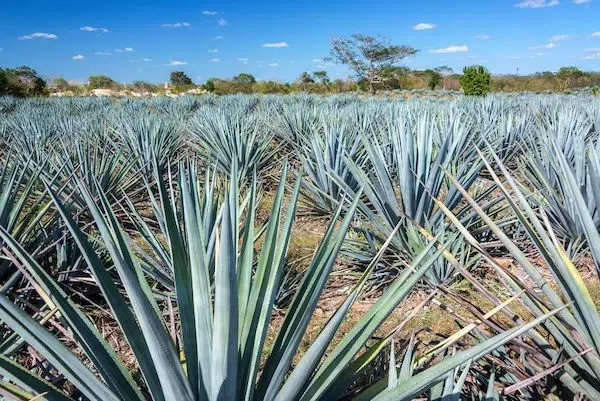
Mixto means that tequila is not only distilled from agave, let me explain. Technically, true tequila can be produced in any of the five states included in the Appellation of Origin, including Jalisco, Nayarit, Michoacán, Guanajuato, and Tamaulipas. These tequilas can either be 100% agave tequila or a mixto. These mixtos use a minimum of 51% agave sugars to distill a spirit.
Here's a quick overview of the differences between a mixto and 100% agave tequila.
As the name implies, the mixto Tequilas are mixed. That means that, before the fermentation process, other sugars are added to the mix.
On paper, most of this sugar still has to come from blue agave. However, on closer inspection, that translates to a reality of 51% natural sugar being enough to classify as a Tequila mixto.
So, half the sugar of a Mixto can be whatever the producers want, which you can also identify by taste. -The agave notes are barely there in some cases. That makes these bottles easier and much cheaper to produce. We highly recommend to only buy 100% agave tequila.
The most annoying part is that you will never find the word "mixto" on a bottle. The Mixto is sold as just "Tequila" all the same. Therefore, only if the bottle states it's 100% agave you know that you have the real deal. Therefore, be wary next time you stock up your home bar.
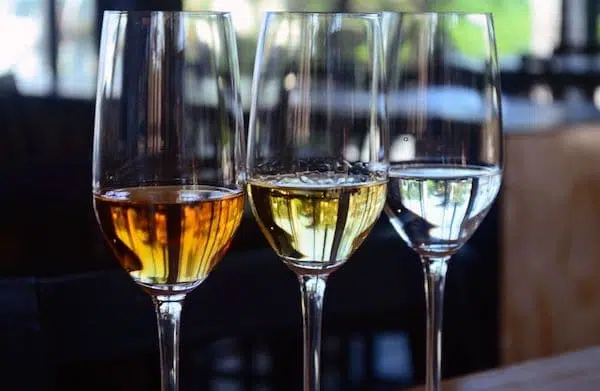
Tequilas of this class are made of blue agave only. They get distilled from the piñas of the blue agave plant without added sugars.
Further, 100% agave Tequila must be bottled within the designated production territory. Usually, those Tequilas are of the highest quality. Thus, ideally, you would only drink Tequila shots that fall into this class. That will save you from some severe headaches.

Tequila is a distilled spirit from Mexico and a specific sub-type of mezcal. It's strictly regulated and can only be produced in a few Mexican states.
While tequila is produced from one type of agave only (blue agave plant or blue Weber agave), you can use an enormous variety of agave plants for the distillation of mezcal. In total, over 30 different maguey may be used to produce mezcal.
However, that's only a quick overview. If you want to learn more about the connection between Mezcal and Tequila, you can read about it in this article dedicated to the differences between Mezcal and Tequila.